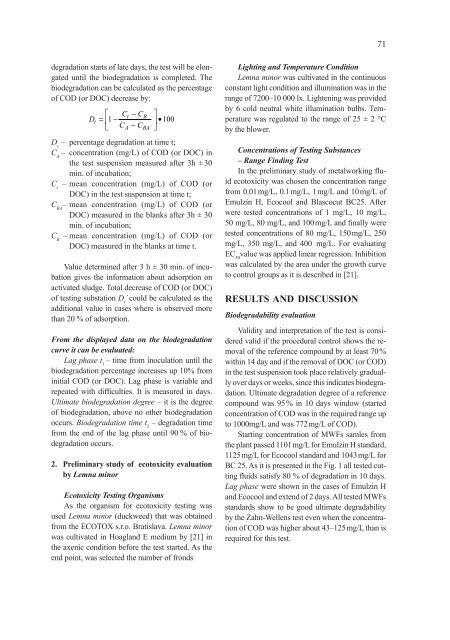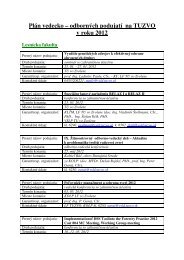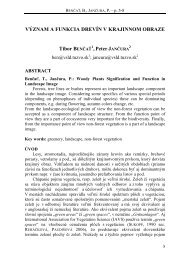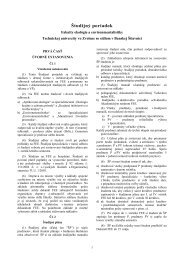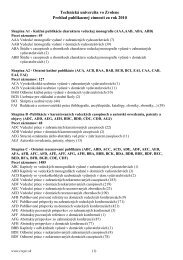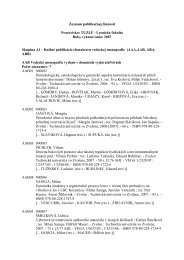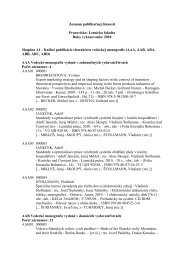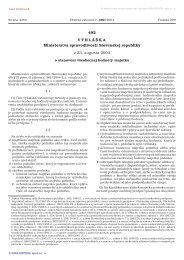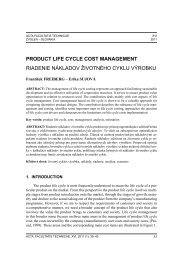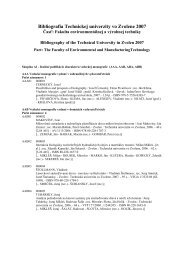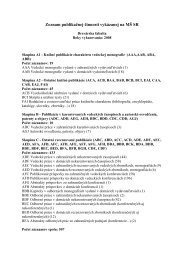Acta Facultatis Ecologiae - Technická univerzita vo Zvolene
Acta Facultatis Ecologiae - Technická univerzita vo Zvolene
Acta Facultatis Ecologiae - Technická univerzita vo Zvolene
- No tags were found...
You also want an ePaper? Increase the reach of your titles
YUMPU automatically turns print PDFs into web optimized ePapers that Google loves.
71degradation starts of late days, the test will be elongateduntil the biodegradation is completed. Thebiodegradation can be calculated as the percentageof COD (or DOC) decrease by:⎡ Ct− CB⎤Dt= ⎢1 − ⎥ • 100⎣ CA− CBA⎦D t– percentage degradation at time t;C A– concentration (mg/L) of COD (or DOC) inthe test suspension measured after 3h ± 30min. of incubation;C t– mean concentration (mg/L) of COD (orDOC) in the test suspension at time t;C BA– mean concentration (mg/L) of COD (orDOC) measured in the blanks after 3h ± 30min. of incubation;C B– mean concentration (mg/L) of COD (orDOC) measured in the blanks at time t.Value determined after 3 h ± 30 min. of incubationgives the information about adsorption onactivated sludge. Total decrease of COD (or DOC)of testing substation D t´ could be calculated as theadditional value in cases where is observed morethan 20 % of adsorption.From the displayed data on the biodegradationcurve it can be evaluated:Lag phase t 1– time from inoculation until thebiodegradation percentage increases up 10% frominitial COD (or DOC). Lag phase is variable andrepeated with difficulties. It is measured in days.Ultimate biodegradation degree – it is the degreeof biodegradation, above no other biodegradationoccurs. Biodegradation time t 2– degradation timefrom the end of the lag phase until 90 % of biodegradationoccurs.2. Preliminary study of ecotoxicity evaluationby Lemna minorEcotoxicity Testing OrganismsAs the organism for ecotoxicity testing wasused Lemna minor (duckweed) that was obtainedfrom the ECOTOX s.r.o. Bratislava. Lemna minorwas cultivated in Hoagland E medium by [21] inthe axenic condition before the test started. As theend point, was selected the number of frondsLighting and Temperature ConditionLemna minor was cultivated in the continuousconstant light condition and illumination was in therange of 7200–10 000 lx. Lightening was providedby 6 cold neutral white illumination bulbs. Temperaturewas regulated to the range of 25 ± 2 °Cby the blower.Concentrations of Testing Substances– Range Finding TestIn the preliminary study of metalworking fluidecotoxicity was chosen the concentration rangefrom 0.01 mg/L, 0.1 mg/L, 1 mg/L and 10 mg/L ofEmulzín H, Ecocool and Blascocut BC25. Afterwere tested concentrations of 1 mg/L, 10 mg/L,50 mg/L, 80 mg/L, and 100 mg/L and finally weretested concentrations of 80 mg/L, 150 mg/L, 250mg/L, 350 mg/L, and 400 mg/L. For evaluatingEC 50value was applied linear regression. Inhibitionwas calculated by the area under the growth curveto control groups as it is described in [21].RESULTS AND DISCUSSIONBiodegradability evaluationValidity and interpretation of the test is consideredvalid if the procedural control shows the removalof the reference compound by at least 70 %within 14 day and if the removal of DOC (or COD)in the test suspension took place relatively graduallyover days or weeks, since this indicates biodegradation.Ultimate degradation degree of a referencecompound was 95 % in 10 days window (startedconcentration of COD was in the required range upto 1000mg/L and was 772 mg/L of COD).Starting concentration of MWFs samles fromthe plant passed 1101 mg/L for Emulzin H standard,1125 mg/L for Ecocool standard and 1043 mg/L forBC 25. As it is presented in the Fig. 1 all tested cuttingfluids satisfy 80 % of degradation in 10 days.Lag phase were shown in the cases of Emulzin Hand Ecocool and extend of 2 days. All tested MWFsstandards show to be good ultimate degradabilityby the Zahn-Wellens test even when the concentrationof COD was higher about 43–125 mg/L than isrequired for this test.


